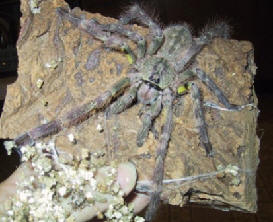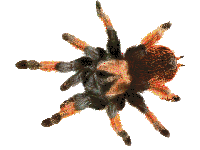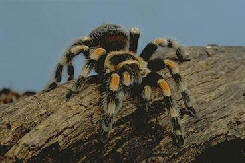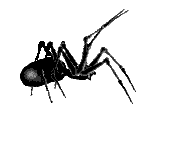 Tarantula
Spider
Tarantula
Spider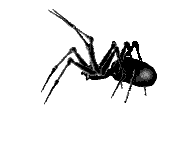
|
Tarantulas are nocturnal creatures and they are considered aggressive. It often lives in silken retreats under the bark or in cavities of dead trees. Tarantulas are found in tropical and desert regions around the world. These spiders hunt prey in both trees and on the ground. The biggest tarantulas can kill animals as large as lizards, mice, or birds. Most tarantulas are harmless to humans, and some species are popular in the exotic pet trade while others are eaten as food. Besides the normal "hairs" covering the body of tarantulas, some also have a dense covering of irritating hairs called urticating hairs, on the opisthosoma, that they sometimes use as a protection against enemies. These fine hairs are barbed and designed to irritate. They can be lethal to small animals such as rodents. Some people are extremely sensitive to these hairs, and develop serious itching and rashes at the site (eyes, nose, and skin) and more dangerously, the lungs and airways, if inhaled. Exposure of the eyes and breathing system to urticating hairs should be strictly avoided. Species with urticating hairs can kick these hairs off: they are flicked into the air at a target using their back pairs of legs. Before biting, tarantulas may signal their intention to attack by rearing up into a "threat posture", which may involve raising their prosoma and lifting their front legs into the air, spreading and extending their fangs, and (in certain species) making a loud hissing noise by stridulating. Their next step, short of biting, may be to slap down on the intruder with their raised front legs. If that response fails to deter the attacker they may next turn away and flick urticating hairs toward the pursuing predator. Their next response may be to leave the scene entirely, but, especially if there is no line of retreat, their final response may also be to whirl suddenly and bite. Tarantulas can be very deceptive in regard to their speed because they may habitually move very slowly, but are able to deliver an alarmingly rapid bite when sufficiently motivated. The length of Tarantulas varies from 6-8 cm (males) to 14-16 cm (females). The largest ever recorded was 20 cm. The legs of a tarantula are banded black and white. It has a yellow colour underneath the first two pairs of legs. It has a dark abdomen with a broad central cream coloured band. Its carapace is grey with cream markings. The largest species of tarantulas can weigh over 9.1 grams. Despite their often scary appearance and reputation, none of the true tarantulas are known to have a bite which is deadly to humans. Because other proteins are included when a toxin is injected, some individuals may suffer severe symptoms due to an allergic reaction rather than to the venom. For both those reasons, and because any deep puncture wound can become infected, care should be taken not to provoke any tarantula into biting. A bite is followed by pain, redness and swelling at the site of the wound. The bite isn't fatal, but in order to avoid bacterial infections you should wash the area with soap and water. Do seek immediate medical treatment if you observe any abnormal allergic reaction. |
